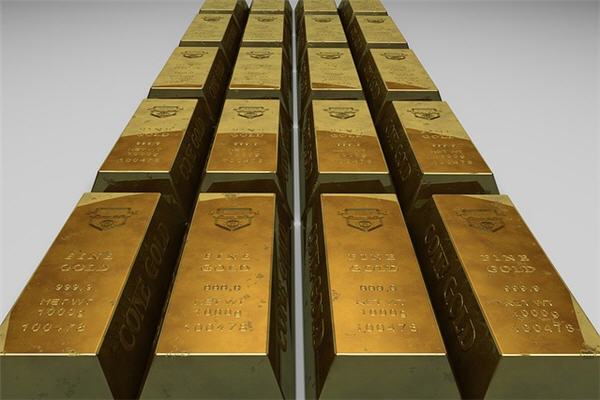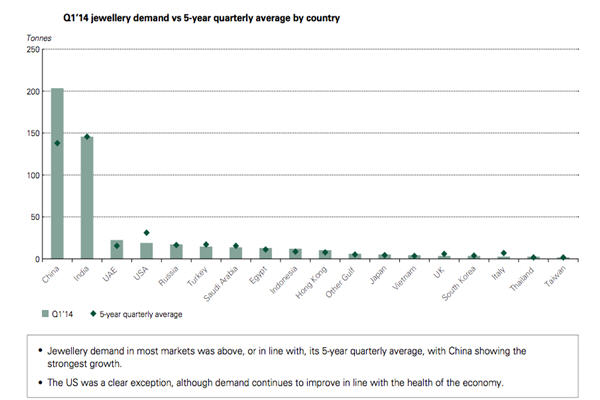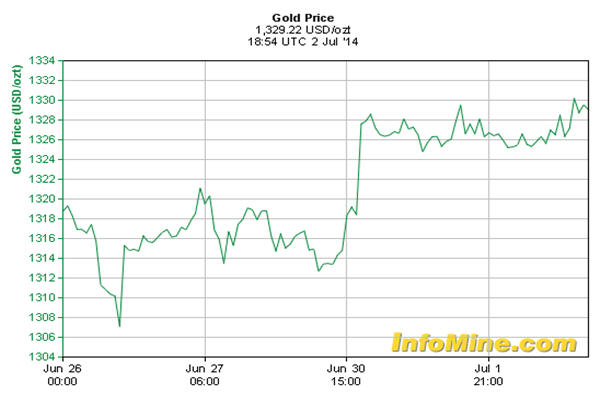Zimbabwe miners to shut down after diamond resource exhausted |
- Zimbabwe miners to shut down after diamond resource exhausted
- A plague on all their houses
- Inflate your way to gold profits with Edward Karr
- Assets in top exchange-traded gold product up most since 2011
- Donald Duck gold coins sold out ‘in minutes’
- BHP may cut more iron ore jobs
| Zimbabwe miners to shut down after diamond resource exhausted Posted: 02 Jul 2014 02:50 PM PDT The Marange diamond deposit, spanning over 300 miles in Eastern Zimbabwe, was stated as the largest diamond mine in the world in 2013 producing almost 17 million carats or approximately 13% of global supply. The diamond field is controlled by Zimbabwe government affiliate Zimbabwe Mining Development Corporation (ZMDC), which has partnership agreements with 7 private entities most of which are speculated to have ties with Zimbabwe ex-military and political officials.  Anjin mine site at Marange. Source: CNN After only 5 years of alluvial diamond production, the easily-minable surface resource at Marange has been rapidly depleted. Beneath the easily-minable loose surface ore, the presence of diamonds continues, but lies in solid conglomerate rock. Mining of the conglomerate rock appears to be uneconomic as it was reported this week that two of the seven miners at Marange, Anjin and Jinan, will be shutting down due to resource exhaustion. On June 30th, Zimbabwe's SW Radio Africa, reported that the two companies will layoff 400 workers this week. Anjin Investments Ltd is a private company joint owned by Matt Bronze Ltd, a company that is principally controlled by Zimbabwe senior ranking military official Charles Tarumbwa and Chinese-based Anhui Foreign Economic Construction Group. Jinan Mining Ltd is a privately-held Chinese-based company.  Anjin mine site at Marange. Source: CNN In September 2013 Belgian and diamond industry officials successfully lobbied the European Union to lift sanctions on Marange diamonds, which allowed for the diamonds to be legally sold in Antwerp, the global diamond hub, for the first time. In March of this year, 380,000 carats Marange diamonds sold in Antwerp for $76 per carat. In February, 950,000 carats sold for an average price of $73/carat. Prior to lifting of sanctions, Marange diamonds were only selling for $33/carat primarily in China, India, and UAE. The importation of Marange diamonds into the U.S. remains illegal due to on-going human right abuses and a history of civil violence tied to the diamonds. The five remaining miners in Marange after Anjin and Jinan shutter will be Mbada Diamonds, Marange Resources, Diamond Mining Company, Gye Nyame Respources, and Kusena Diamonds.  A rough diamond. Source: De Beers Group While its difficult to estimate Marange production for 2014, its likely that output will be significantly lower than the 16.9 million carats produced in 2013. In 2012 Marange produced 12 million carats; in 2011 8.7 million carats; in 2010 8.7 million carats; in 2009 800,000 carats; and in 2008 600,000 carats. Today the largest diamond mine in the world is Botswana's Orapa mine estimated to produce 13 million carats this year. Orapa is jointly owned by De Beers and the government of Botswana. About the Author: Paul Zimnisky has worked in the financial industry for over 10 years as an arbitrage trader, equity analyst, and Exchange Traded Fund creator and developer. Paul closely follows the global financial markets, gold, diamonds, and the U.S. energy industry. Paul has been interviewed and quoted by numerous financial media outlets including Bloomberg TV, Fox Business News, the Economist, Barron's, Forbes, and Investors Business Daily. Paul graduated from the University of Maryland's Robert H. Smith School of Business with a B.S. in Finance. Paul can be reached at PaulZimnisky@gmail.com. |
| Posted: 02 Jul 2014 02:34 PM PDT There is a definite Jacobin vibe in the air these days. By all reports a guillotine has been set up on Bay Street and all the aristos of the mining class that can be found are being hunted down, loaded into the tumbrels and dispatched to the "unkindest cut of all". Some reports claim that 50% of the CEOs of major miners have gone under the blade in the last two years. A myriad of lesser fry have been garroted down the back alleyways of Vancouver, having been deemed unworthy of the public spectacle of their punishment. Why is there this revolutionary mood in the air? Certainly the great and powerful of the largest miners lived large in the fat years and the milk and honey flowed their way. Some of the lesser lights though have been on a strict bread and water diet since 2008 and now find their reward is to also face an ignominious end. Who though is the Robespierre in the current scenario? We do not see analysts baying for blood. Investment banks are too wary of calling the demise of an executive who has padded their own pockets in the past through fees and may yet survive a coup. Journalists may allude to the excesses of dumb M&A or failed projects with elephantine capexes (Pascua Lama, Tasiast etc) but they rarely name names of those who should pay the price. There would seem to be a strange dichotomy whereby most of the greater victims of this purge are the result of board action and many of the lesser victims have fallen prey to the increasingly odious trend towards shareholder activism. The most notable, for us, of the latter trend was the ousting of management at Maudore Minerals by a group claiming superior skills that have since only excelled in gross incompetence and value destruction. We have spoken in the past of collective responsibility of boards, particularly at the majors. Boards at juniors frequently have non-executive directors who are scarcely paid or not paid at all. Particularly inrecent years the compensation has shrunk to wads of way out-of-the-money options (which remind us of those Weimar shoppers with wheelbarrows of Reichsmarks going to buy their bread) so it is unreasonable to expect that these board members are spending vast amounts of time micromanaging the management. At the larger companies though the directors are compensated in many and various ways and yet when the cock crows three times the directors cry in unison "We didn't approve what he was doing" and throw the CEO to the wolves. In so many of the cases the most damning thing is that the axed CEO goes on to do better things elsewhere while the replacement struggles just as much (and sometimes even worse) with a surly board and whatever inherent problems the company might have with its property or project. Ditching the CEO does not fix a project with dubious grades, funky mineralogy or defective economics. You cannot make a silk purse out of a sow's ear. As for the activist investors they are the plague in our time. Every trumped up holder of 5-10% can lurk under Canadian rules without disclosing themselves ready to leap out of the shadows and mug management when they want to make a power grab. Frequently they represent over 20% of the shares and take cover behind the Canadian regulators definition of "institutional managers" in the Early Warning System to NOT declare themselves insiders. They claim they are not discretionary fund managers but when push comes to shove they are voting way more shares than they ever declared publicly. They do not want to be insiders but they nevertheless heavy managements into leaking them tidbits which they then act upon (or not) as the mood takes them. When we think activist we think of those acting to remove egregious entrenched and overweening managements. Instead now "activist" in the Canadian mining context means a lone wolf or wolf pack trying to extract added value for themselves with no advantage for the Great Unwashed on the company's share register. To add insult to injury, when these carpetbaggers summon an EGM the whole cost of the enterprise falls upon the company (ergo the rest of the shareholders) and even an uncontested EGM request (i.e. one without proxy solicitors or legal input) costs $20,000 at least to have the share register drawn up and the voting materials dispatched. At the very least the costs of these EGMs should fall upon those that chose to call them. This would then create a cost to focus the minds of "activists" who think they can stage a coup and bill the company for the bullets. Frankly management in the mining space is what it is… We would like to see whole boards go at badly managed majors rather than just a salutary victim "pour encourager les autres". Collective responsibility has been replaced by collectively pushing the CEO under the bus. |
| Inflate your way to gold profits with Edward Karr Posted: 02 Jul 2014 12:47 PM PDT
The Gold Report: Let's talk about the Foreign Account Tax Compliance Act (FATCA) of 2010. What is the FATCA regulation? Edward Karr: In March 2010, Congress passed the Hiring Incentives to Restore Employment Act. The HIRE Act was intended to stimulate domestic jobs in the U.S. FATCA was quietly slipped in as a very small part of the HIRE Act. In a nutshell, FATCA makes every overseas bank, financial company, hedge fund, mutual fund, broker, and dealer an enforcement agent of the U.S. Internal Revenue Service. Starting July 1, 2014, these financial institutions are required to turn over their data on U.S. clients' and U.S. persons' accounts. Implementing FATCA is costly because many foreign financial institutions did not have the compliance systems and information technology in place to report on U.S. persons' holdings. Banks are being forced to spend tens of millions of dollars to upgrade their systems. And if they do not provide the information to the U.S., the penalties are extremely severe. The U.S. government can levy a 30% withholding penalty on any business that the institution does in the U.S., including trading U.S. dollars, equities, bonds and fixed income instruments. Noncompliance effectively locks a firm out of the U.S. markets. TGR: FATCA was set up to stop people from cheating on their taxes; will it have some effect? EK: FATCA goes after a mosquito with a sledgehammer—or in mining terms, uses a D11 bulldozer to move a small pebble. There are 7.6 million (7.6M) U.S. citizens living outside the U.S. who are caught up in this war on tax evasion. However, an organization called Republicans Overseas is launching a constitutional challenge to FATCA lawyered by Jim Bopp. He is the attorney who took down the McCain–Feingold campaign finance law in the Supreme Court. Bopp is confident that FATCA will be overturned. TGR: Looking forward, then, what is the economic outlook in Europe for gold, commodities and stocks? EK: The overall European economic outlook is the same muddle-through situation that has dominated the continent for the last couple of years: slow economic growth and possible deflation. After the financial crisis of 2008–2009, the U.S. proactively recapitalized the financial system in the U.S. The European banks still need to be recapitalized. The European Central Bank (ECB) has done a really good job in defending the euro, but the underlying problem of high debt levels on the banks' balance sheets has not been addressed. Greece is not really a big problem, but keep a close eye on France. It has a very slow growth rate, high debt levels and is basically an economic train wreck in slow motion. In addition, we are seeing a resurgence of ultranationalism in the polls. Europe desperately needs inflation. Deflation, of course, is a central banker's worst nightmare. The bankers need inflation to avoid deflation. The ECB is going to have to start running the money printing presses around the clock. I just see no other way out of the dilemma. The banks can only inflate their way out of their crushing debt loads. And rising, higher inflation means higher interest rates, which is very positive for the gold markets. TGR: How will higher interest rates impact the gold markets? EK: As inflation and interest rates rise, so does the consumer demand for gold. People buy gold as a safe haven and a store of value. I have a positive outlook for gold and gold equities as Europe recapitalizes its banking systems and the prices of precious metals explode upward. TGR: What about banking systems in other areas of the world? EK: China escaped its last financial crisis with a massive government stimulus program. As a result, China is trapped inside one of the biggest credit bubbles in the history of the human race. Some people believe that when the bubble pops there will be a very hard landing. But with the stroke of a pen, the Chinese government can address economic issues much more effectively than a bunch of European bureaucrats sitting around a table. TGR: Will inflation hit the U.S? EK: Because the U.S. banking system is in great relative shape, there will be a resurgence of domestic manufacturing. The U.S. has a lot of land and has plenty of capital and technological savvy. It has abundant, cheap energy compared to the rest of the world. As the manufacturing economy takes off, inflation will gradually pick up there, too, which is positive for gold. Today's gold price of $1,319/ounce ($1,319/oz) is the new base price, in my opinion. Precious metal stocks are extremely cheap right now. This is a great time to buy. TGR: Do you have any precious metals stock picks for us today? EK: I like the metal royalty companies, such as Franco-Nevada Corp. (FNV:TSX; FNV:NYSE), Royal Gold Inc. (RGLD:NASDAQ; RGL:TSX) and Silver Wheaton Corp. (SLW:TSX; SLW:NYSE). These stocks should be core positions in any portfolio. They are going to continue to do exceedingly well regardless of where the underlying precious metals prices go. TGR: What are some of the juniors that you like? EK: My number one pick is Pershing Gold Corp. (PGLC:OTCBB). I have been a Pershing shareholder for a few years, and it has been exciting to watch the company develop. Pershing Gold is headed by CEO Steve Alfers. He is an experienced mining attorney with a great reputation in the U.S. He is a very seasoned deal guy and has put several mines into production. Alfers stepped down as COO of Franco-Nevada to become the CEO of Pershing Gold. That is a huge statement in and of its own—that he would leave a functioning major to run a junior. And Alfers has assembled a phenomenal team at Pershing Gold. TGR: What are Pershing Gold's assets? EK: Pershing Gold's major asset is the Relief Canyon project. Relief Canyon has three open-pit mines and a state-of-the-art, fully permitted and operational heap-leach facility. It is a shovel-ready project, fast-tracked to go into production by the end of this year. And Pershing Gold has just announced a new discovery, which is two miles north of its three main pits. That property is very close to the border with Coeur Mining Inc.'s (CDM:TSX; CDE:NYSE) Rochester mine. Coeur Mining is already a shareholder in Pershing Gold and knows the situation on the ground very well. This discovery is a brand new, high-grade mineralization system that could very easily extend up into the Rochester mine/Coeur Mining properties. Pershing Gold has already announced some drill results at very good grades. Pershing Gold has announced a recovery rate of 81.8%. Pershing is also forecasting about an 80,000 oz (80 Koz) per year production; Pershing's all-in costs should come in at $750/oz. TGR: Are there other companies operating in the same area? EK: Pershing Gold has a northern neighbor named Midway Gold Corp. (MDW:TSX.V; MDW:NYSE.MKT). Midway Gold's Pan project is similar to Relief Canyon. The Pan project has a projected nine-year mine life with 81 Koz/year production. The fully loaded cost is $824/oz with a 75% recovery rate. TGR: How do you compare the two companies? EK: Midway had 180M shares outstanding, fully diluted, prior to its last bought deal. It recently did a financing of $25M at $0.83/share for an additional 30M shares. In addition, it had to issue 4M shares to Hale Capital Partners L.P. to approve that deal. If we add that to the $55M in project financing that Midway arranged at the end of May, there is an enterprise value on Midway Gold right now of $235M. This compares with Pershing Gold's debt-free current market cap of approximately $108M. I fully expect Pershing's market cap to trade up in line with Midway's in the future. I really like Midway and the Pan project, but I love Pershing Gold and Relief Canyon. Pershing Gold is one of the most undervalued and exciting Nevada gold exploration and near-term production stories on the market today. TGR: Pershing has 25,000 acres around the Relief Canyon mine. What's the role of the Bureau of Land Management (BLM) in regard to its operation? EK: Pershing is moving into fast-track permitting right now. It has the permits needed. The company is in constant contact with the BLM, and that process is moving forward at a very fast pace. TGR: Do you expect to see a significant bump in Pershing Gold's share price in the short term? EK: The discussions with the BLM to reopen the mine under either the current or the amended plan of operations could be a major catalyst. Seeing more results from the target two miles north of the main three pits could be a big catalyst. Cantor Fitzgerald issued a research report on Pershing Gold at the end of May. It put a $0.55 price target on the stock. When gold moves back up to $1,400–1,500/oz, investors will get tremendous leverage on the Pershing stock. TGR: What about Mexico? Any juniors there that you like? EK: Kootenay Silver Inc. (KTN:TSX.V) has a 100-million ounce (100 Moz) Measured and Indicated silver resource at its flagship project, Promontorio. The company has a great management team in mining-friendly Mexico. A while back, the stock sold off from the $0.80/share range to $0.30. Kootenay is small, with only 63M shares outstanding. If we value it at $1/oz for its proven 100 Moz deposit, we are looking at a potential $100M market cap plus its ongoing blue sky exploration opportunities. At $0.30/share with just 63M shares out, Kootenay is trading at a CA$19M market cap. As the silver market turns and heads higher, cheap companies like Kootenay will be acquired at substantial premiums. TGR: Does Kootenay have the cash to keep operating in the interim? EK: It has just announced a $2.5M financing at $0.30/share. That will provide enough cash to keep its exploration program well funded, while Kootenay continues to build out ounces and the market turns up. TGR: What other gold juniors are sleeping lions? EK: I am actively involved with InCoR Holdings Plc (ICR:GXG). It is a natural resource holding company with several exciting ventures, including the largest sawmill in the Republic of Georgia. InCoR Holdings is listed on the GXG global exchange, which is a new Danish stock market with operational headquarters in London. The firm has a division called InCoR Technologies that is developing a "starved acid leaching" technology (SALT). This new scientific method applies to the recovery of nickel and other metals from laterite ores, including saprolite ores that are below the current cutoff grade of the conventional smelting process. Nickel production worldwide is generally divided between primary sulphidic ores and the more weathered laterite ores. The nickel sulphidic ores are being depleted, and the costs of building and operating nickel processing plants for nickel laterites are very high and, in most cases, economically marginal given where we are today with nickel prices. That fact has caused many global development projects to be postponed. Generally, a nickel laterite ore with a grade in the range of 1.8% nickel or higher is needed to cover costs of production. SALT presents real competitive advantages over the existing technology because its capital costs are a magnitude of order less than the high-pressure acid leaching, which is the industry standard right now for the extraction of nickel from laterites. The founder and driving force of SALT is Dr. David Dreisinger. He is a professor at the University of British Columbia and one of the world's leading metallurgists. We feel that SALT is a major company maker. But a word of caution. InCoR Holdings, as I mentioned, does trade on the GXG global exchange. We helped the company with its public listing. We are shareholders. But the stock is very illiquid at the moment, and it is a real micro-cap issue. This is not a stock to chase. It is a stock to put on your radar screen and watch. TGR: Thanks for your time. Edward Karr is the founder of RAMPartners S.A., an investment management and investment banking firm based in Geneva. Since 2005, RAMPartners has helped raise more than $200 million for small capitalization companies in fields such as natural resources, high technology, health care and clean energy. Prior to founding RAMPartners, Karr worked for a private Swiss asset management, investment banking and trading firm based in Geneva. Prior to moving to Europe, Karr worked for Prudential Securities in the United States and has been in the financial services industry for 20 years. Before his entry into the financial services arena, Karr was affiliated with the United States Antarctic Program and spent 13 consecutive months working in the Antarctic, receiving the Antarctic Service Medal for his contributions of courage, sacrifice and devotion. Karr studied at Embry-Riddle Aeronautical University and Lansdowne College in London, England, and received a Bachelor of Science in economics/finance with honors from Southern New Hampshire University. Want to read more Gold Report interviews like this? Sign up for our free e-newsletter, and you'll learn when new articles have been published. To see recent interviews with industry analysts and commentators, visit ourStreetwise Interviews page. DISCLOSURE: Streetwise – The Gold Report is Copyright © 2014 by Streetwise Reports LLC. All rights are reserved. Streetwise Reports LLC hereby grants an unrestricted license to use or disseminate this copyrighted material (i) only in whole (and always including this disclaimer), but (ii) never in part. Streetwise Reports LLC does not guarantee the accuracy or thoroughness of the information reported. Streetwise Reports LLC receives a fee from companies that are listed on the home page in the In This Issue section. Their sponsor pages may be considered advertising for the purposes of 18 U.S.C. 1734. Participating companies provide the logos used in The Gold Report. These logos are trademarks and are the property of the individual companies. 101 Second St., Suite 110 Tel.: (707) 981-8999 |
| Assets in top exchange-traded gold product up most since 2011 Posted: 02 Jul 2014 12:25 PM PDT Assets in the world's biggest exchange-traded bullion product made their largest two-day gain since 2011 on Wednesday, with violence in Iraq and Ukraine buttressing demand. Holdings in the SPDR Gold Trust increased 1.4% to 796.39 tonnes in the two sessions through Tuesday, Bloomberg reported, adding that it is the biggest two-day gain since November 2011. Demand for the precious metal is especially strong in Asia, the most active bullion-buying region, with China and India accounting for the majority of the demand. According to The Wall Street Journal, demand rose to a record 1,100 tonnes in China last year and was estimated at 975 tons in India. "Market fundamentals in Asia remains intact and is getting stronger," the newspaper quoted Albert Cheng, managing director for the Far East at the World Gold Council, as saying. Gold futures for August delivery traded Wednesday morning at $1,329.80 per ounce on the Comex division of the New York Mercantile Exchange, up from the previous close of $1,326.60. Gold has benefited from not only geopolitical tensions but also the US central bank saying that interest rates will remain low for the foreseeable future, sparking worries about inflation. During times of political or financial turmoil, market participants tend to buy gold, which is seen as a safe-haven investment. |
| Donald Duck gold coins sold out ‘in minutes’ Posted: 02 Jul 2014 11:42 AM PDT One thousand Donald Duck gold coins made by New Zealand's and Australia's Mints sold out in the first 10 minutes after their release last week and are now being traded on auction websites for a 100% profit. According to the mint, the only remaining ones are silver coins, which —just like their bullion version— show the Disney character as it appeared for the first time 80 years ago, wearing his trademark sailor suit and bow tie, in "The Wise Little Hen" (1934). Coin collectors seem to be among the few ones who have not lost their faith in gold. The Donald Duck coins follow gold and silver ones released in April, which depicted Mickey Mouse and that also sold out within days. Experts believe that, beyond collectors push, coin sales have been lifted by gold's reputation as a safe haven. As inflation increases, the value of money drops and the prices of all goods increase. Consumers prefer to hold gold instead of cash during these periods as gold acts as a value retainer for them. |
| BHP may cut more iron ore jobs Posted: 02 Jul 2014 10:50 AM PDT
BHP Billiton (NYSE: BHP) (LON: BLT) may lay off more staff as part of its ongoing efforts to increase the profitability of its northwestern Australia iron ore operations. The job cuts are thought to involve planning and development positions at its iron ore divisional headquarters in Perth and at centres in Western Australia's Pilbara region. The company has already cut more than 500 jobs, including 100 from the divisional office in Perth. Another 170 jobs have been cut at the mining giant's Whaleback mine in Pilbara. According to The Wall Street Journal, Melbourne-based BHP said Wednesday that it has no job-cut target numbers. "It is very difficult for me to give precise answers as to what that all works out to," the paper quoted Jimmy Wilson, president of BHP's iron ore unit, as saying. "Our aspiration is to at least hold our headcount the same or reduce it while we are increasing our volumes." Wilson also said that any further layoffs would have no connection with the price of iron ore, a key component of steel. Iron ore is down 30% this year after a relatively quiet 2013. On March 10 this year, it suffered its worst one-day decline since the financial crisis of 2008-2009. |
| You are subscribed to email updates from MINING.com To stop receiving these emails, you may unsubscribe now. | Email delivery powered by Google |
| Google Inc., 20 West Kinzie, Chicago IL USA 60610 | |






0 Comment for "Zimbabwe miners to shut down after diamond resource exhausted"